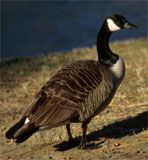| Contact us |
| Try wildfowling |
| Club merchandise |
| Wildfowl art |
| Wildfowling books |
| Join KWCA |
| Search |

Geese in Kent
by Alan Jarrett
A new member to the club – albeit one with a lapsed membership to
his name - rang to report his duckless opening day of the season. Lots
of geese though – "I frightened one!" was the cheerful
response to my query.
The nub of the story was his conversation with a birdwatcher back at the
car park, when they discussed the ever-growing numbers of geese in the
locality. Our new member had explained how at one time there had been
no geese at all until the club – the KWCA – had begun a release
programme, supported by a 10-year moratorium on shooting. Now geese were
everywhere.
"He was friendly enough, but I’m not sure he believed me you
know." Oh well!
Two days before I lay up in a four-foot deep gutter. The sea purslane
to my front was springy and almost shrub-like in its unique way, with
stiff flat fleshy leaves and sinewy stalks coming together to provide
the perfect cover from which it was possible to peer with little likelihood
of being seen.
I little way off the sea lavender carpeted the marsh in delightful subtlety
of colour and fragrance, and these carpets lay in almost patchwork formation
throughout this saltmarsh. Here and there a lower patch of stodgy ground
held the occasional winter flood when the spring tides came over and left
a salty residue for a few days.
Tiredness from the largely sleepless all-night vigil and a hot sun make
for comfortless bedfellows, and the wildfowlers’ enjoyment soon turns
to endurance.
Off to the south-east the horizon was broken by the approach of a skein
of Canada geese. They came on, wavering slightly in that tantalising manner
which only geese seem capable of. Would a shot be on or not? The moments
of indefinable mounting excitement as the deep, bass calls drift across
the saltmarsh for the first time.
It is always the same this moment of anticipation before the birds arrive
within the killing arc. Will they, won’t they? Keep down until the
last moment – check what the dogs are doing, whilst the crescendo
of calls grow ever louder as the moment of truth arrives.
Then they are sweeping past on deceptively beating wings that seem so
slow but are in truth surprisingly swift. What a marvelous thing is this
computer/brain which can calculate angles and speeds and deliver a killing
strike in a blink of an eye.
The first shot is perhaps more of a conscious act. Careful not to underestimate
the speed, yet move the gun ahead and keep pushing through to fire. The
bird is falling, and now the computer really takes over; there is the
dimly held thought that the angle of the second bird is so different now
that the skein is in panic – shoot down the left-hand side of the
bird and it too collapses.
Now move on for that elusive treble, at a bird which is moving fast across
and away. The angle is different again, needing more lead, just a touch
of left-hand side and a little drop to take account of the departing bird.
It too lies among the purslane.
The older bitch brings a big bird with her head held high against the
weight of a 12lb Canada. She struggles with the load but eventually becomes
jammed at the rim of a creek, unable to make further progress but unwilling
to let go. It is the work of a moment to lie among the purslane, to reach
down for a great black paddle and heave the big bird from the creek.
Huge birds, perhaps disappointingly drab among our wildfowl were it not
for the black face and clean white cheeks behind a crisp black bill. A
powerful master of the airways, but brought to book by one of those responsible
for their widespread presence on these marshes.
So the club had worked hard over many years to establish Canadas, but
especially greylag. Greys brought from Scotland as eggs or goslings, to
be reared lovingly and released onto protected sites; greys protected
by that long non-shooting period from which club members now benefit so
hugely.
In my early wildfowling years it was rare to see or even hear a goose
much before the turn of the year. Even then it was only because we are
one of the few areas in England where the European white-front over-winters.
The white-fronts still come – even if changing habits make their
demise more difficult than ever before – but the mainstay for the
Kentish goose hunter are the Canada and greylag.
The marshes and estuaries resound to their calls, and there can be few
enthusiasts abroad – be they wildfowler, birdwatcher or rambler –
who can fail to stand awhile and marvel at their passing. In bringing
these birds to Kent the wildfowlers brought a slice of magic to this corner
of England, so that today Kent remains known as the Garden of England
and famed for its hops – it is now also noted for its wild geese.